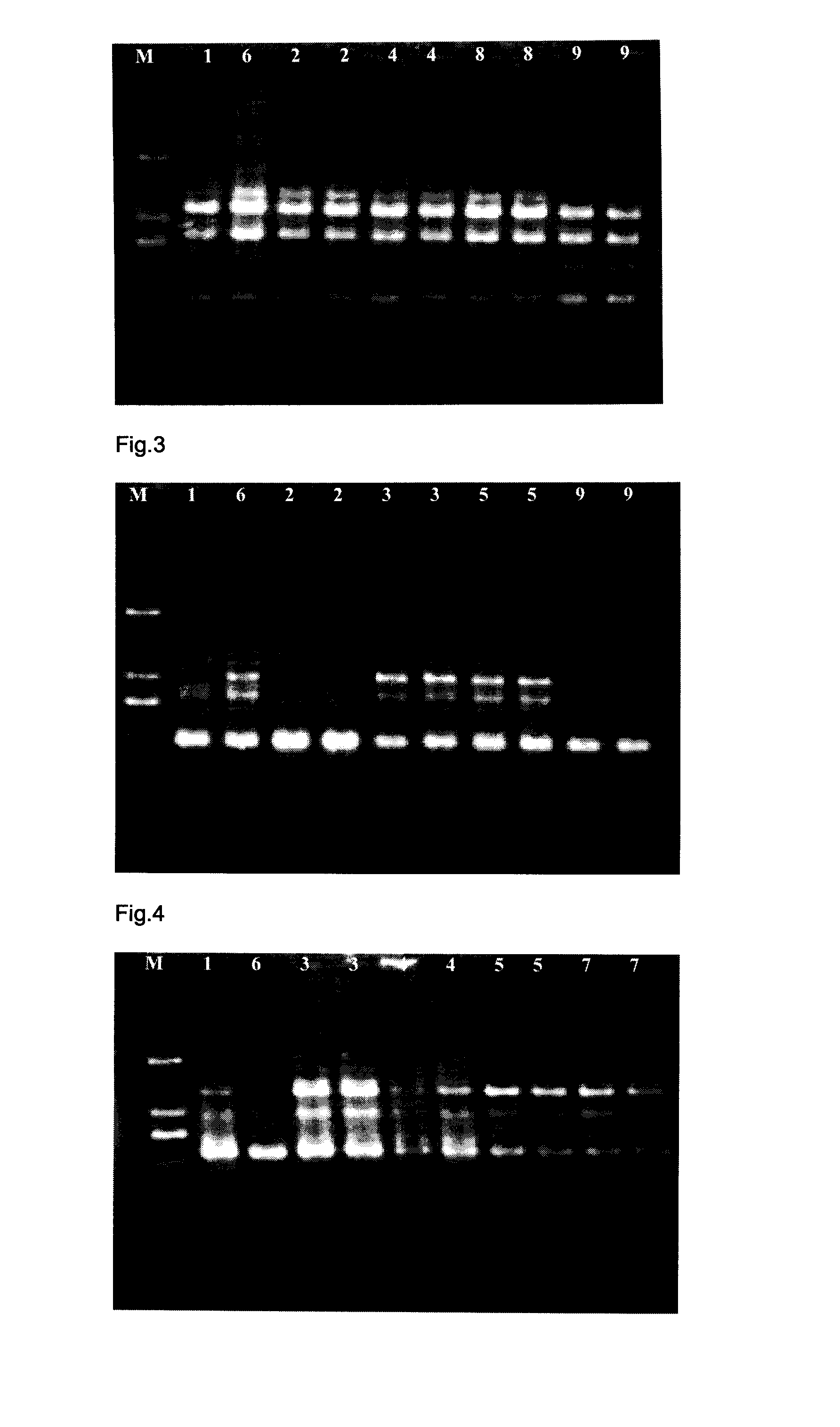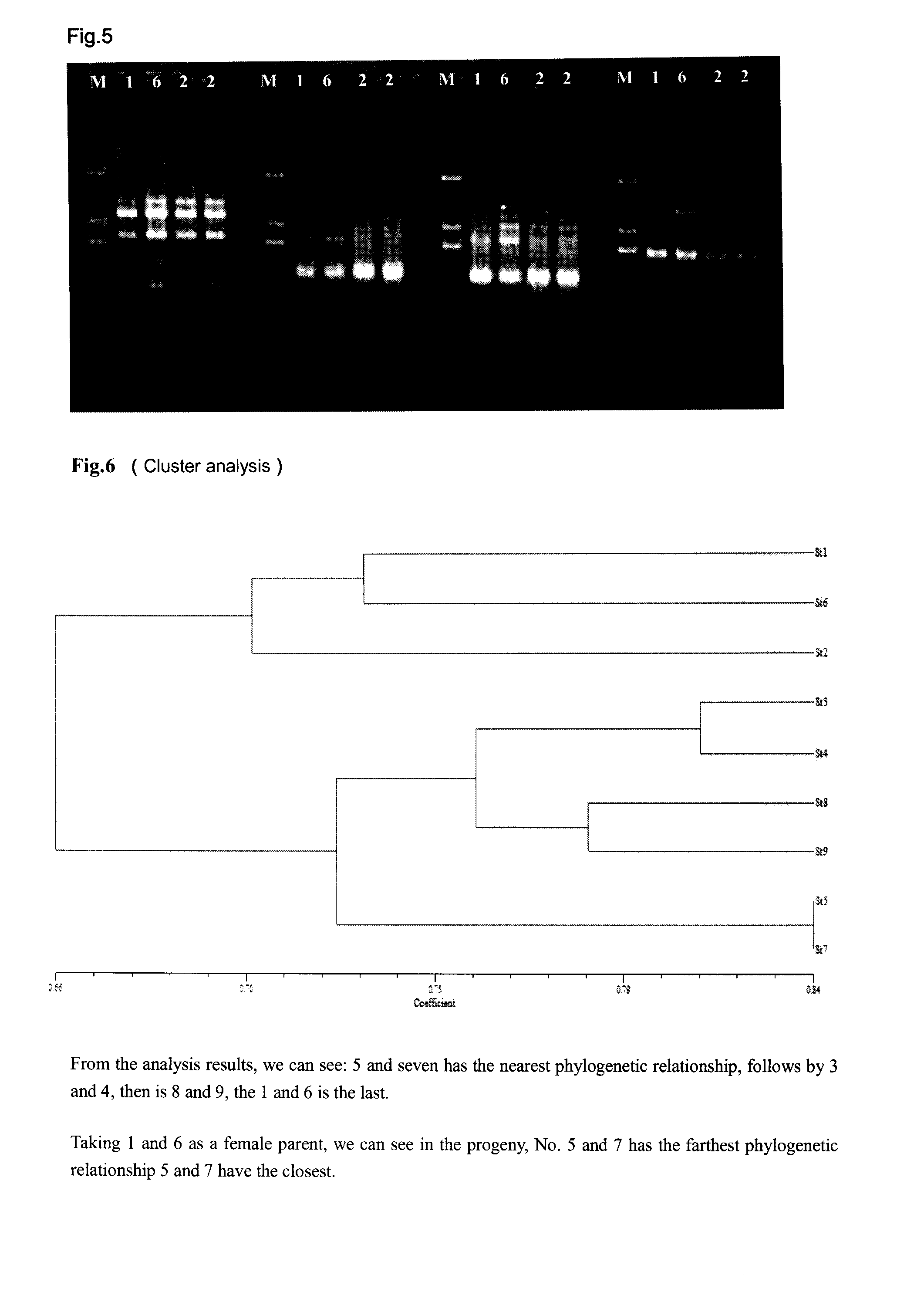High Rebaudioside-A Plant and Methods of Producing the Same and Uses Thereof
a high-rebaudioside, plant technology, applied in the field of producing elite stevia rebaudiana, can solve the problems of high cost of production, poor taste quality, and poor taste of natural sweeteners, and achieve the effects of improving the content of ra, high yield of leaves, and high content of total glycosid
- Summary
- Abstract
- Description
- Claims
- Application Information
AI Technical Summary
Benefits of technology
Problems solved by technology
Method used
Image
Examples
example 1
[0172]Plant Materials:
[0173]No. 2 (H5 or High STV#2), No. 3 (Runde #4), No. 4 (China A #3), No. 5 (Runde #, No. 7 (H4 or Runde#1, No. 8 (Morita#2, No. 9 (H3 or Runde #18) were obtained after crossing the No. 1 (Waimao #3) and No. 6 (Morita #3. An ISSR fingerprint of No. 9 accessions showed that No. 8 was the same as the parents, while No. 2, No. 3, No. 4, No. 5, No. 7 and No. 9 were all different from the parents (refer to FIGS. 1-5)
[0174]Methods:
[0175]The genomic DNA was extracted from the stevia leaves of both parents and seven accessions using a Plant Genomic DNA Miniprep Kit. The yields and qualities of extracted DNA were checked by a UV / vis spectrophotometer and electrophoresis on 1.0% agarose gels.
[0176]Nine ISSR primers out of 125 based on dinucleotide, tetranucleotide or pentanucleotide repeats produced clear and reproducible fragments of all DNA of stevia accessions. The PCR reaction mixture consisted of 30 ng / μl genomic DNA 2.0 μl, 10× buffer 2.0 μl, 25 mM / L, ddH2O 12.6 μL...
example 2
GLG Stevia H2, H3, H4 and H5 DNA Molecular Identification Report (AT Lab) Instructions
[0184]A: as Morita #2;
[0185]B: as H3 mother (B6);
[0186]C: as H5 father;
[0187]D: as Morita #3;
[0188]E: as H4;
[0189]F: as H5;
[0190]G: as H3 mother (B4);
[0191]H: as H3 mother (J3);
[0192]I: as H2;
[0193]J: as H3;
[0194]K: as DC#1;
[0195]L: as C1.
[0196]Results: FIG. 7.
example 3
Extraction of Steviol Glycosides from Stevia Rebaudiana Leaves
[0197]One kg of the stevia leaves known to have a high content of Rebaudioside A were steeped with 2 kg of room temperature water having a pH of 7.3 in an agitation centrifuge. The leaves were agitated for 0.5 hour. The sweet water was filtered, the filtrate collected and the process repeated for a total of 5 steep / separation cycles. The pH of the sweet water filtrate solution was adjusted to pH 8.0 with approximately 30 grams of calcium hydroxide. After a rest time of about 1 hour, 50 grams of FeCl3 was added to the sweet water filtrate solution to further adjust the pH to 7.0. The solution was filtered and the resulting filtrate had a transmittance of about 68±2% at 325 nm. The filtrate flows through the resin bed, and the glycosides was eluted from the resin bed by using 75% of ethanol. The eluate was concentrated to 45-50% of solid content, and then was vacuum dried. This dried eluate is called stevia extract or Stevi...
PUM
| Property | Measurement | Unit |
|---|---|---|
| Weight | aaaaa | aaaaa |
| Electrical resistance | aaaaa | aaaaa |
| Ratio | aaaaa | aaaaa |
Abstract
Description
Claims
Application Information
 Login to View More
Login to View More - R&D
- Intellectual Property
- Life Sciences
- Materials
- Tech Scout
- Unparalleled Data Quality
- Higher Quality Content
- 60% Fewer Hallucinations
Browse by: Latest US Patents, China's latest patents, Technical Efficacy Thesaurus, Application Domain, Technology Topic, Popular Technical Reports.
© 2025 PatSnap. All rights reserved.Legal|Privacy policy|Modern Slavery Act Transparency Statement|Sitemap|About US| Contact US: help@patsnap.com



